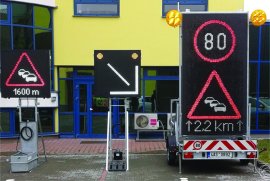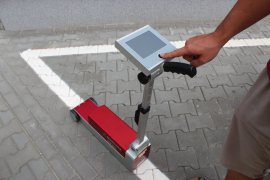Traffic sign laboratory
The services of the laboratory are conditioned mostly for traffic signage providers (governors and owners of roads). As the people in charge, they should check the basic properties and parameters of both vertical and horizontal traffic signs over regular time intervals and verify their endurance and functional parameters. The monitoring also serves to verify the traffic sign parameters as a basis for setting their current optical qualities before the end of their warranty..

Traffic sign laboratory [ 1.17 MB]
Improving the quality and monitoring of traffic signs
Roads are equipped with traffic signs which must comply with respective standards and regulations. The qualitative parameters that the signage must fulfill according to these materials may be established and checked using specialized instruments. These instruments exist for vertical traffic signs as well as for horizontal traffic signs. Our laboratory ultilizes the latest instruments that are currently on the market. The discovered findings are recorded in an accredited lab protocol where the measured values are presented.
The laboratories are acredited by the Czech Accreditation Institute with the number 1506 and the title „Transport Research Centre Laboratory“ (Laboratoř centra dopravního výzkumu). It conducts tests of optical characteristics of vertical traffic signs and horizontal traffic signage, roughness/anti-skidding properties of roads and horizontal traffic signage surfaces.
Options for the measuring of traffic signage parameters:
Horizontal traffic signage:
- Trichromatic coordinates and luminosity factor, Determines the color quality of light on the x, y axes in a colorimetric triangle CIE and the luminosity factor.
- Specific luminosity coefficient - RL, Determines the visibility of horizontal traffic signs as seen by drivers when lit by their headlights (night visibility).
- Luminosity coefficient in diffused lighting - Qd, Determines the visibility of horizontal traffic signs as seen by drivers in daylight or in artificial lighting (day visibility).
- Roughness/anti-skidding properties.
Determines the value of the roughness of horizontal traffic signage surface using a pendulum.
Vertical traffic signage:
- Retroreflection coefficient - RA,
Determines the visibility of vertical traffic signs as seen by drivers when lit by their headlights. - Luminance and chromaticity
Determines the color quality of light on the x, y axes in a colorimetric triangle CIE and the luminosity factor.
Measuring methods
For the measuring of the above mentioned parameters, we have a trained staff and the latest equipment, e.g.: HunterLab MiniScan EZ, Zehntner ZRM 6014, Zehntner ZRS 6060, Stanley London pendulum for roughness measuring.
- HunterLab MiniScan EZ
This spectrophotometer is an instrument designed to measure trichromatic coordinates and luminosity factors. It is equipped with the 45°/0° measuring geometry and it may be used to measure samples both in the lab and on-site in the field. - Zehntner ZRS 6060
This retroreflectometer is an instrument designed to measure the RA retroreflection coefficient for vertical traffic signs or other similar materials. The instrument is equipped with three viewing angles and one lighting angle. - Zehntner ZRM 6014
This retroreflectometer is an instrument designed to measure the RL luminosity coefficient and the Qd luminosity coefficient in diffused lighting. - Stanley London
This pendulum is an instrument designed to measure the roughness of horizontal traffic signage or road surfaces.
Contact
Photogallery



